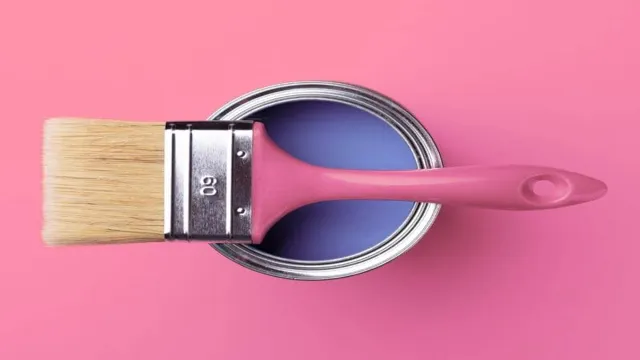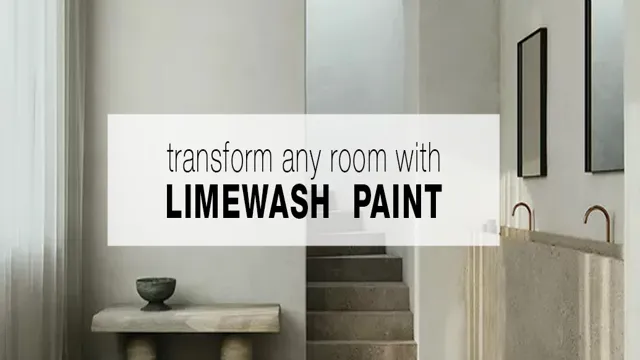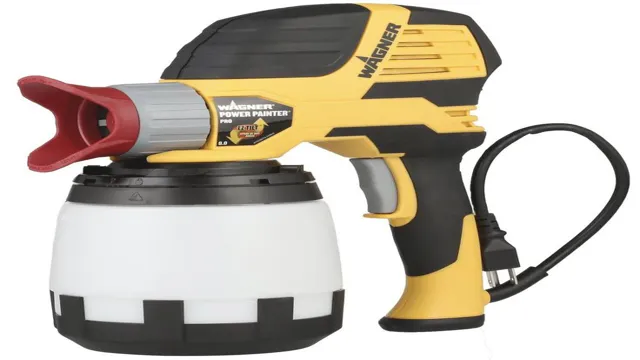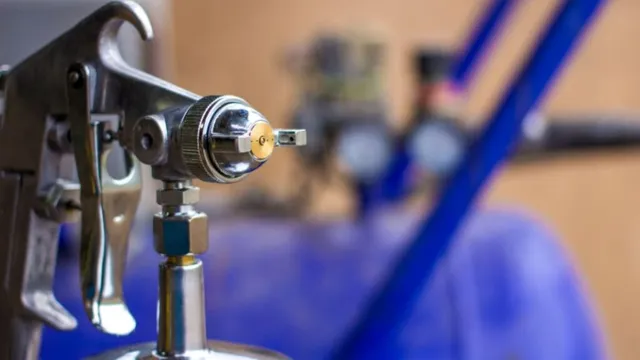Can You Use a Paint Sprayer for Limewash? Pros and Cons You Need to Know

Looking to update the exterior of your home or business with a fresh coat of limewash but not sure if using a paint sprayer is the way to go? Well, wonder no more! As it turns out, using a paint sprayer for limewash is not only possible but can actually make the job easier and more efficient. Say goodbye to the tedious process of hand-brushing and hello to a more streamlined approach. But, before you bust out your trusty paint sprayer, there are a few things you should consider to ensure the best results.
In this blog, we’ll explore the ins and outs of using a paint sprayer for limewash, from the benefits to the potential drawbacks, and everything in between. So, grab your tool belt and let’s get started!
Understanding Limewash and Paint Sprayers
Limewash is a popular choice for those who want to achieve a unique, aged look on their walls and other surfaces. And while you might be used to using a traditional paint sprayer for your painting projects, you may be wondering if a paint sprayer can be used for limewash as well. The answer is yes, you can use a paint sprayer for applying limewash.
However, special care must be taken to ensure that the sprayer is compatible with the type of limewash you are using. Some sprayers may not be able to handle the thicker consistency of limewash, while others may not be designed for use with mineral-based paints. It’s worth doing some research to find a sprayer that is best suited for your specific limewashing project.
What is Limewash?
Limewash is a type of paint made from slaked lime, water, and pigments. This ancient paint is still used today because of its unique finish and natural durability. The Limewash creates a matte, chalky finish and can give any surface a rustic, traditional look.
Using a paint sprayer to apply Limewash is much more efficient and effective than traditional methods. Unlike brushing or rolling, which can cause streaks and inconsistent coverage, a paint sprayer can evenly coat the surface and apply the Limewash in a fraction of the time. Limewash is also eco-friendly and highly breathable, which means it allows moisture to escape, reducing the risk of mold and water damage.
If you’re looking to update your home with a classic look and environmentally friendly option, Limewash is the perfect choice.

What are Paint Sprayers?
Paint sprayers are tools that can simplify the process of painting. They function by spraying paint onto a surface through the use of an airless or compressed air system. Compared to traditional painting methods, paint sprayers can provide a smoother finish, faster coverage, and less overspray.
However, not all kinds of paint can be sprayed, and not all surfaces are suitable for spraying. Limewash, for example, is a traditional coating material that can give surfaces a natural, matte appearance. It is typically applied manually using a brush or roller.
While it can be challenging to use paint sprayers on limewash directly, they can be used to apply a diluted version of the coating for a more consistent finish. When considering using paint sprayers, it is essential to understand the materials and surfaces involved to achieve optimal results.
Can You Use a Paint Sprayer for Limewash?
Yes, you can use a paint sprayer for limewash. In fact, using a sprayer allows for a more efficient and consistent application of the limewash. However, it’s important to ensure that your sprayer is compatible with the thickness and texture of the limewash you plan to use.
You’ll also want to be cautious about overspray and ensure that you’re aiming the sprayer in the right direction. It’s important to note that while a sprayer may make the application process easier, the preparation work and clean-up afterwards may require a bit more effort and time. Overall, using a sprayer for limewash can provide great results, but it’s important to proceed with caution and do your research to ensure that you’re using the right technique and equipment.
Advantages of Using a Paint Sprayer for Limewash
When it comes to applying limewash, many people wonder if they can use a paint sprayer instead of traditional methods like brushes or rollers. The answer is yes, you can use a paint sprayer for limewash, and it actually offers some advantages over other application methods. One of the biggest benefits is speed – a sprayer can cover large surfaces quickly and evenly, saving time and effort compared to using a roller or brush.
Additionally, sprayers can produce a more consistent finish with fewer streaks or variations in color, giving your walls a more professional look. The main thing to keep in mind when using a sprayer for limewash is to make sure you adjust the nozzle to the thinnest setting possible, and take care to avoid overspray. With a bit of practice and careful attention, using a sprayer for limewash can be a convenient and effective choice for your next project.
Choosing the Right Paint Sprayer for Limewash
Limewash, Paint Sprayer, Choosing When it comes to giving any surface a limewash finish, paint sprayers can be quite useful. However, it is important to choose the right paint sprayer for the job. Not all paint sprayers are designed to handle limewash properly, so you need to do your research before investing in one.
It is best to opt for a sprayer with a larger nozzle size, such as a 0.23 or 0.25, as this will help prevent clogging and allow the limewash to flow smoothly.
Additionally, it is important to make sure the sprayer has an adjustable pressure setting, as this will allow you to control the flow of the limewash and achieve the desired texture. By choosing the right paint sprayer for your limewashing project, you can save time and achieve a high-quality, even finish.
Preparing and Applying Limewash with a Paint Sprayer
Yes, it is possible to use a paint sprayer for applying limewash. In fact, using a paint sprayer can make the process of applying limewash much simpler and quicker. When preparing limewash for the sprayer, it is important to mix it properly to achieve a consistent texture.
It is recommended to use a fine mesh strainer when transferring the solution to the sprayer to avoid any clogs. When applying the limewash with the sprayer, make sure to work evenly and consistently, overlapping strokes to avoid any missed spots. Overall, using a paint sprayer can save time and reduce the physical effort needed for applying limewash onto walls or other surfaces.
However, it is important to choose the appropriate nozzle size and to follow the manufacturer’s instructions for using the paint sprayer.
Tips and Tricks for Using a Paint Sprayer for Limewash
Many people wonder whether they can use a paint sprayer for limewash. The answer is yes, you can! In fact, using a paint sprayer for limewash can save you a lot of time and effort compared to applying it by hand. However, there are some tips and tricks you should keep in mind to ensure that you get the best results.
Firstly, it’s important to choose the right type of paint sprayer for the job. A handheld sprayer with a fine mist nozzle is a great choice for small to medium-sized projects, while larger projects may require a more heavy-duty airless sprayer. It’s also crucial to ensure that your sprayer is properly maintained and cleaned before and after each use.
Limewash is known to clog sprayer nozzles, so it’s important to clean your machine thoroughly to avoid any potential issues. Additionally, it’s important to properly dilute your limewash before using it in your sprayer. Diluting the limewash too much can result in a thinner coat that may not provide adequate coverage, while not diluting it enough can clog your sprayer and cause uneven coverage.
Overall, using a paint sprayer for limewash can be a game-changer when it comes to achieving beautiful, even coverage on your walls or furniture. By following these tips and tricks, you can ensure that your sprayer is properly maintained and your limewashing projects are a success.
Practice and Experimentation
When it comes to using a paint sprayer for limewash, practice is key. Before starting on your project, experiment with the sprayer and limewash on a small, inconspicuous area to get a feel for the spray pattern and coverage. It’s also important to use the right tip size for your paint sprayer, as this can greatly affect the amount and consistency of the limewash being applied.
If you’re unsure of the correct tip size, consult the manufacturer’s guidelines or a paint professional for advice. Another tip is to keep your sprayer nozzle at a consistent distance from the surface being painted, typically around 6-8 inches, to ensure even application. And, as with any painting project, be sure to properly prepare the surface beforehand, including cleaning and priming if necessary, for the best results.
With these tips and some practice, using a paint sprayer for limewash can be a fast and efficient way to achieve a beautiful, durable finish.
Masking and Safety Precautions
When using a paint sprayer for limewashing your walls, it is important to take safety precautions and wear protective gear to avoid inhaling the paint mist or getting it on your skin. Using a respirator, safety glasses, and gloves can greatly reduce your chances of adverse health effects. Additionally, you should take care to mask off areas where you don’t want the limewash to go, such as windows or trim.
This can be done using plastic sheeting and painter’s tape. Before starting, make sure to also cover nearby furniture or other items with drop cloths to avoid any accidental drips or splatters. Proper safety and preparation can make the process of using a paint sprayer for limewashing simpler and much safer.
Conclusion
In conclusion, while a paint sprayer may seem like a convenient option for applying limewash, it’s important to consider the unique properties and consistency of limewash. Ultimately, a brush or roller may be a more effective and precise choice for achieving the desired look and texture. But hey, if you’re feeling adventurous, go ahead and give that paint sprayer a try.
Just be prepared to embrace the unpredictable charm of limewash!”
FAQs
What is limewash and how is it different from regular paint?
Limewash is a type of paint made from limestone, water and natural pigments, while regular paint is usually made from synthetic ingredients. Limewash gives a unique textured finish that can’t be replicated with regular paint.
Can you use a paint sprayer for limewash?
Yes, you can use a paint sprayer for applying limewash. However, make sure to use a sprayer designed for thicker substances and to thin the limewash appropriately.
How long does limewash last on exterior walls?
Limewash can last up to 10 years on exterior walls, depending on the climate and other environmental factors.
Can you apply limewash over existing paint?
Yes, you can apply limewash over existing paint, as long as the surface is clean and free of peeling paint or other debris.
Is limewash a good option for historic homes?
Yes, limewash is a great option for historic homes since it was commonly used on traditional buildings and it gives a natural, breathable finish that won’t trap moisture.
Does limewash require a primer?
No, limewash does not require a primer. However, it’s recommended to apply a limewash undercoat to ensure proper adhesion and coverage.
How can I remove limewash from a surface?
Limewash can be removed with a power washer or scraper, or by applying a solution of equal parts vinegar and water and scrubbing with a stiff brush.



